
Concept explainers
Calculate the voltage labeled vx in Fig. 7.52, assuming the circuit has been running a very long time, if (a) a 10 Ω resistor is connected between terminals x and y; (b) a 1 H inductor is connected between terminals x and y; (c) a 1 F capacitor is connected between terminals x and y; (d) a 4 H inductor in parallel with a 1 Ω resistor is connected between terminals x and y.
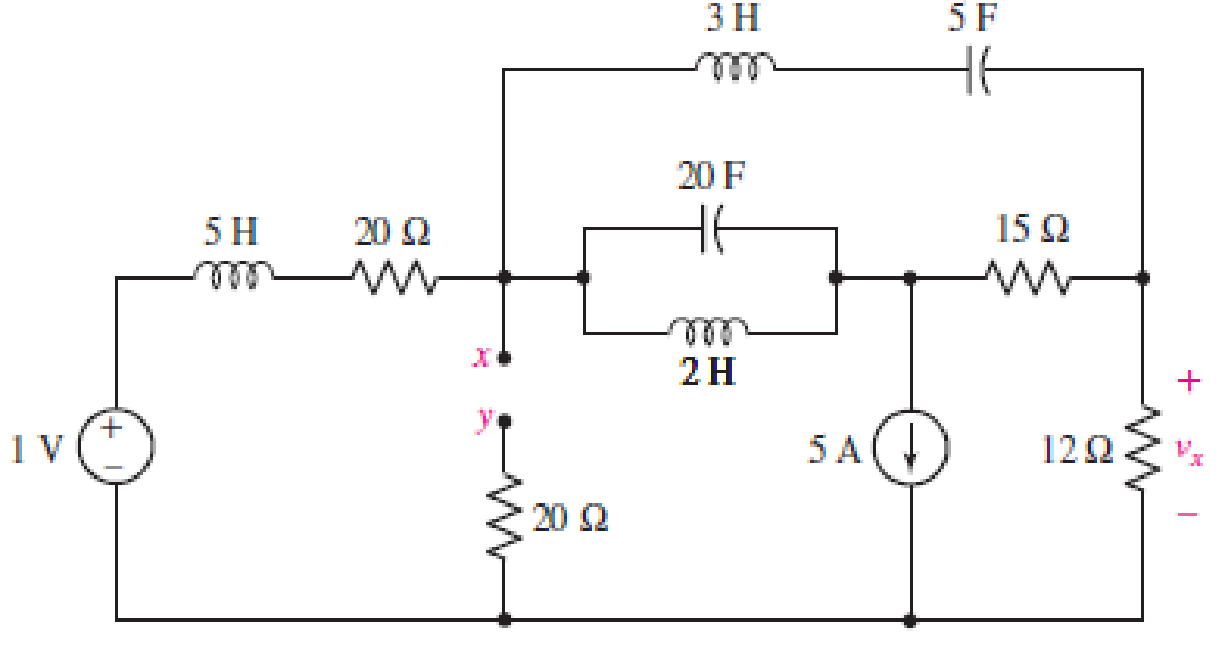
FIGURE 7.52
(a)
Find the voltage
Answer to Problem 29E
The voltage
Explanation of Solution
Given data:
Value of resistance connected between terminals
Calculation:
The redrawn circuit is shown in Figure 1 as follows:
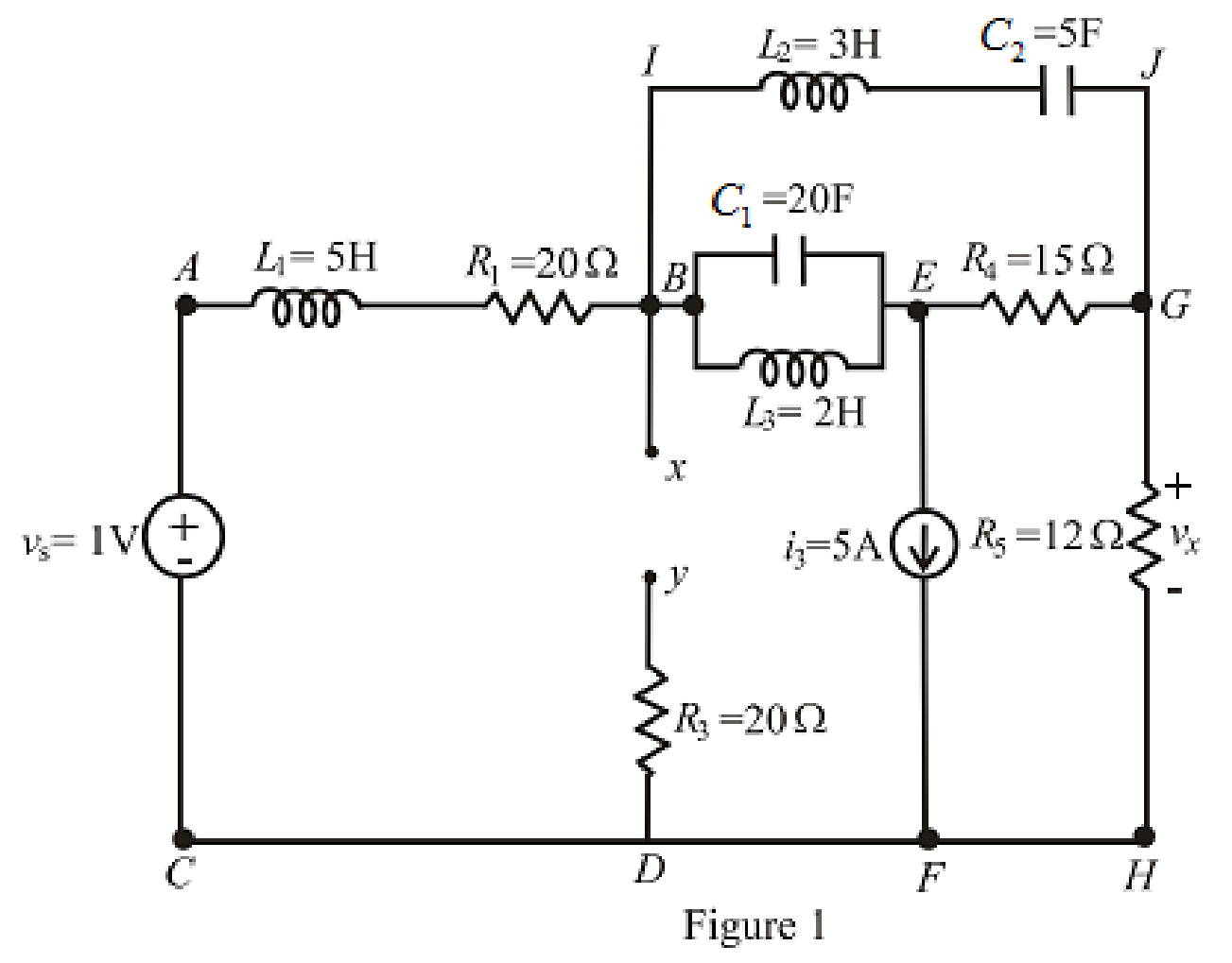
Here,
The redrawn circuit is shown in Figure 2.
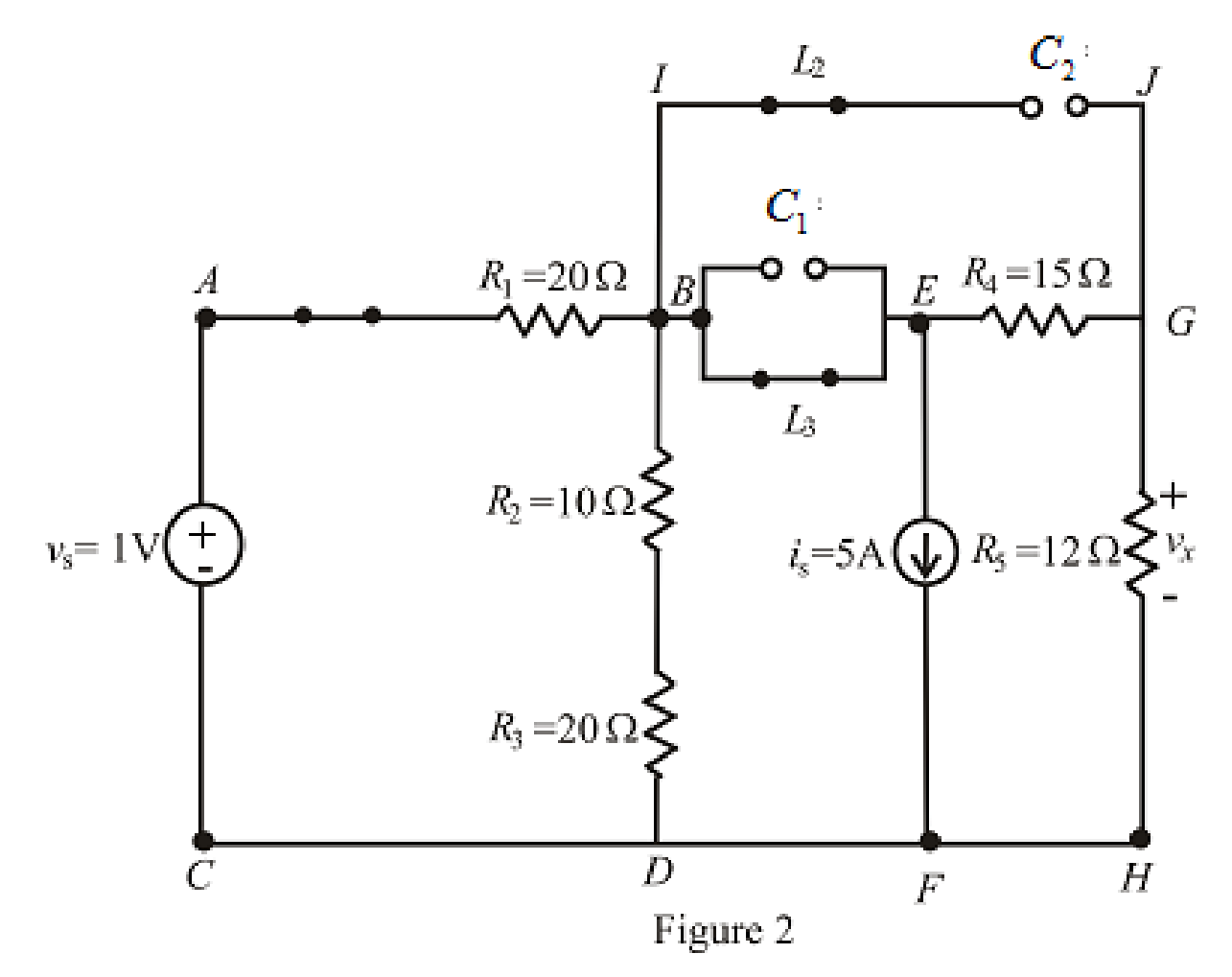
Refer to the Figure 2:
When steady state is reached, all the inductors connected are short circuited and all the capacitors connected are open circuited.
The equivalent resistance for series combination across branch is as follows:
Substitute
The redrawn circuit is shown in Figure 3 as follows:

Refer to the redrawn Figure 3:
The expression for the nodal analysis at node voltage
Here,
The expression for the current across the resistance
The expression for the voltage across the resistance
The current across the resistances
Substitute
Solve for
Substitute
Substitute
Conclusion:
Thus, the voltage
(b)
Find the voltage
Answer to Problem 29E
The voltage
Explanation of Solution
Given Data:
Value of inductor connected between terminals
Calculation:
The redrawn circuit with inductor connected across branch
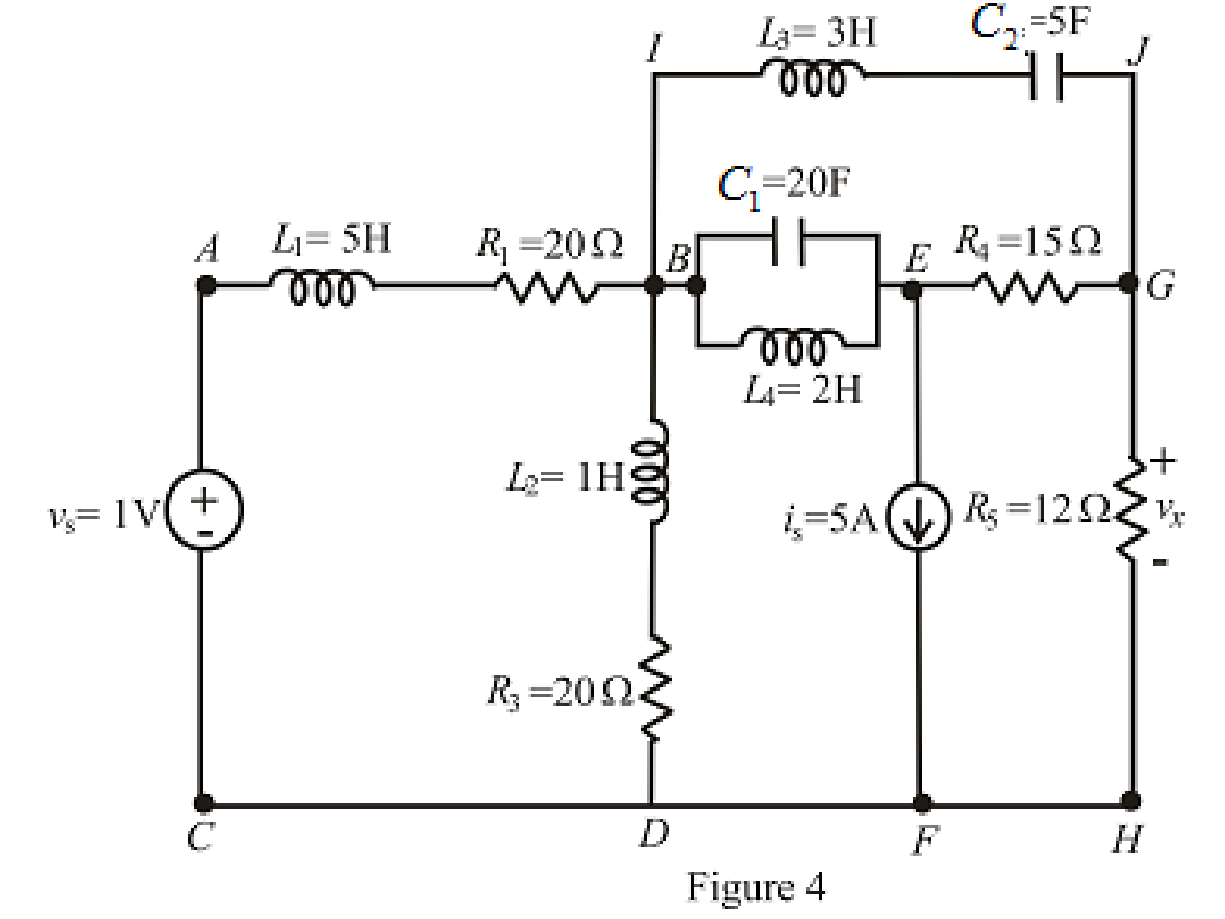
The redrawn circuit is shown in Figure 4 as follows:

Refer to the Figure 5:
When steady state is reached, the inductor connected across branch
The redrawn circuit is shown in Figure 6 as follows:
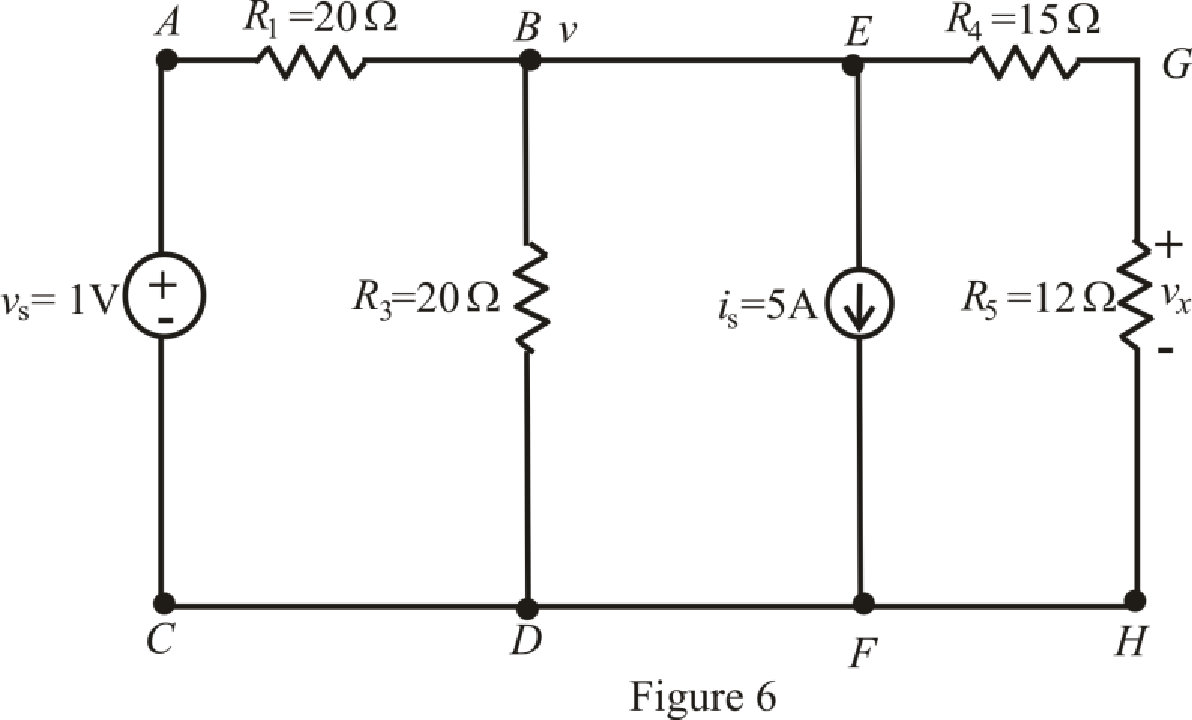
The expression for the nodal analysis at node voltage
The expression for the current across the resistance
The expression for the current across the resistance
The current across the resistances
Substitute
Solve for
Substitute
Substitute
Conclusion:
Thus, the voltage
(c)
Find the voltage
Answer to Problem 29E
The voltage
Explanation of Solution
Given data:
Value of capacitor connected between terminals
Calculation:
The redrawn circuit of capacitor connected across branch
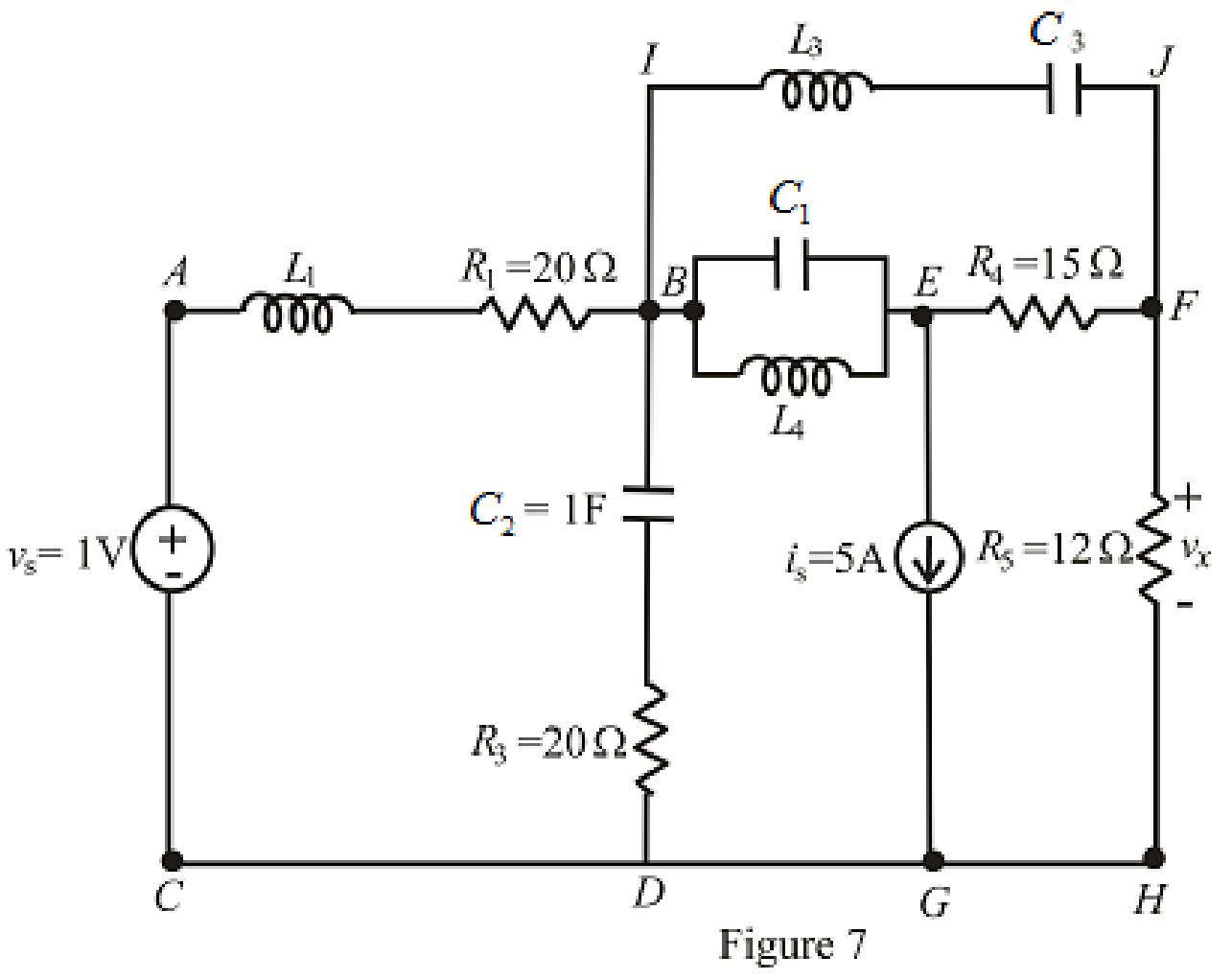
Refer to the redrawn Figure 7:
The redrawn circuit is shown in Figure 8 as follows:
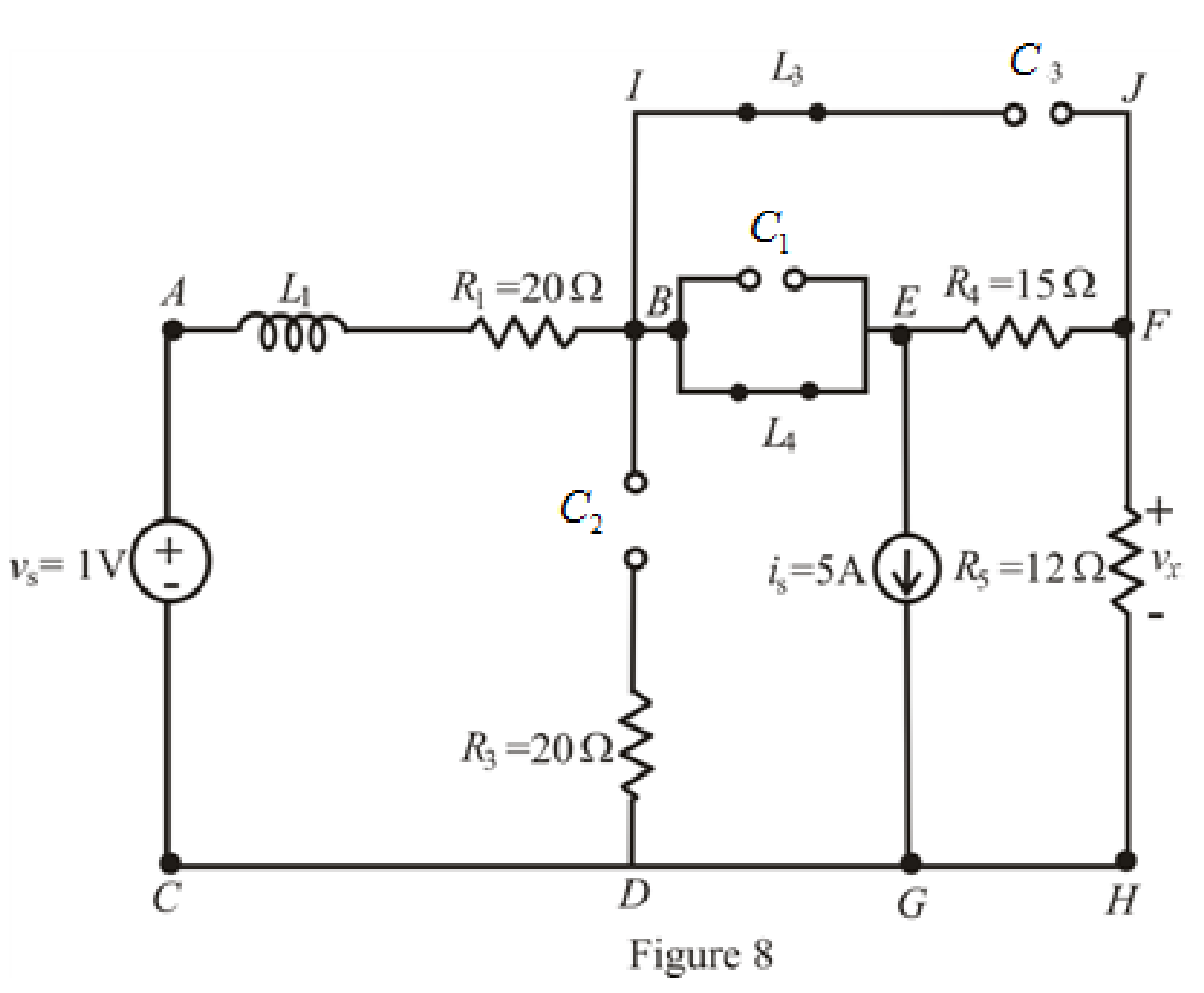
When steady state is reached, thecapacitors connected across branch
The redrawn circuit is shown in Figure 9 as follows:
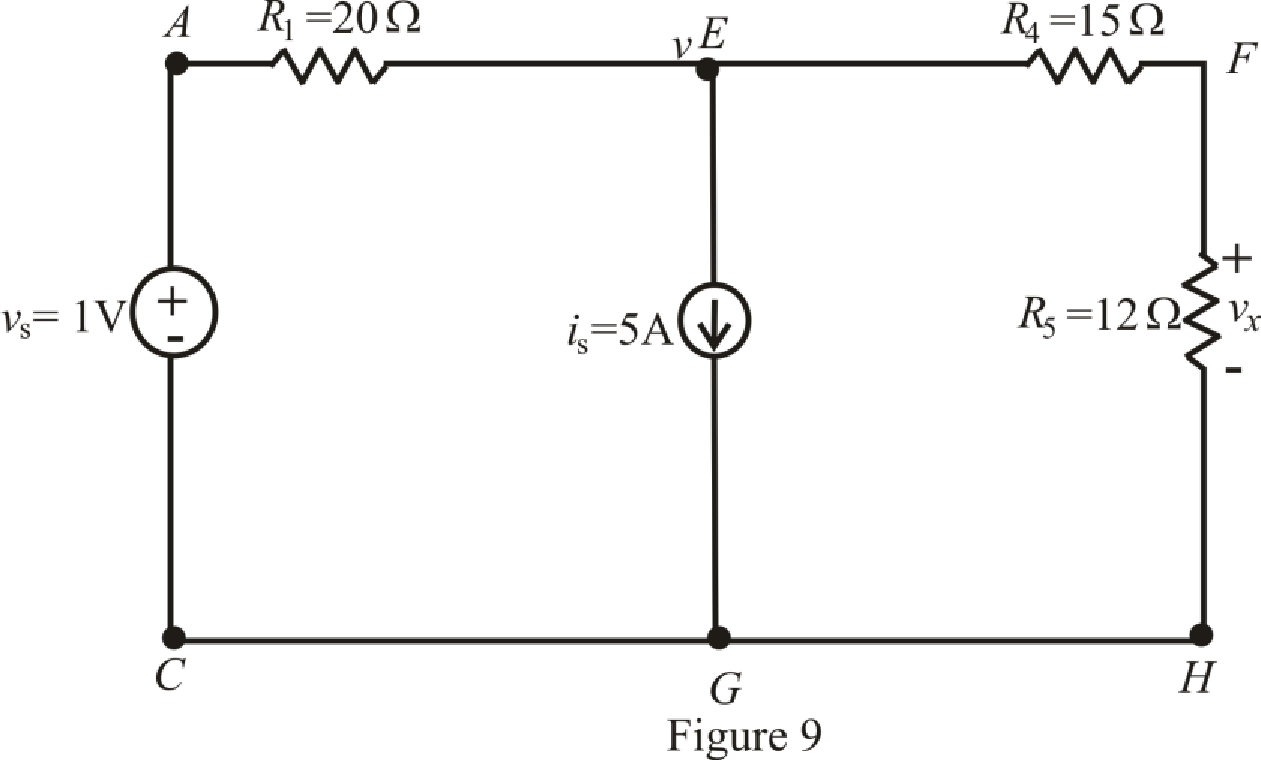
Refer to the Figure 9:
The expression for the nodal analysis at node voltage
The expression for the current across the resistance
The expression for the voltage across the resistance
The current across the resistances
Substitute
Solve for
Substitute
Substitute
Conclusion:
Thus, the voltage
(d)
Find the voltage
Answer to Problem 29E
The voltage
Explanation of Solution
Given Data:
Value of inductor connected between terminal
Value of resistor connected in parallel with inductor across terminal
Calculation:
The redrawn circuit is shown in Figure 10:
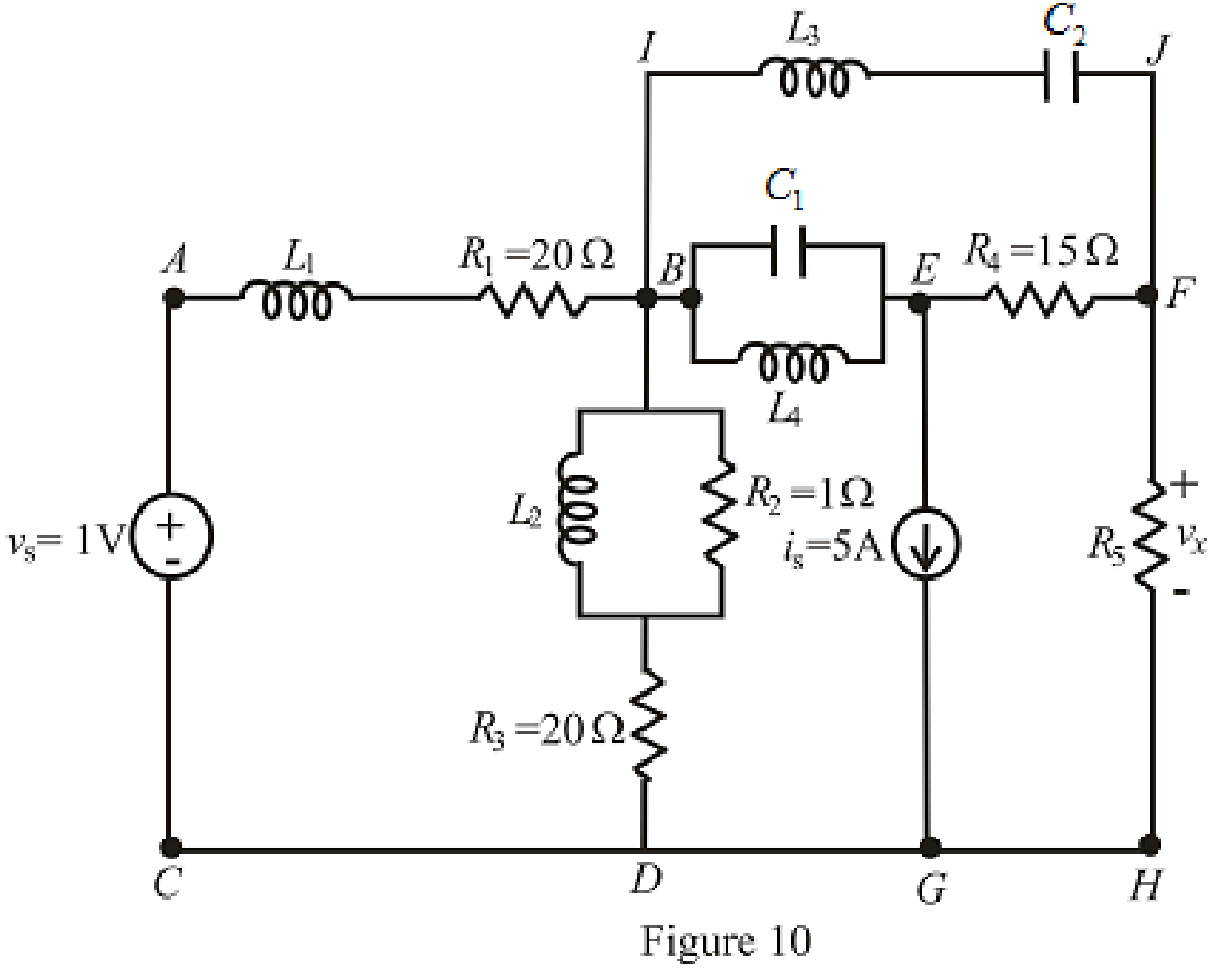
Refer to the redrawn Figure 10:
The redrawn circuit is shown in Figure 11 as follows:
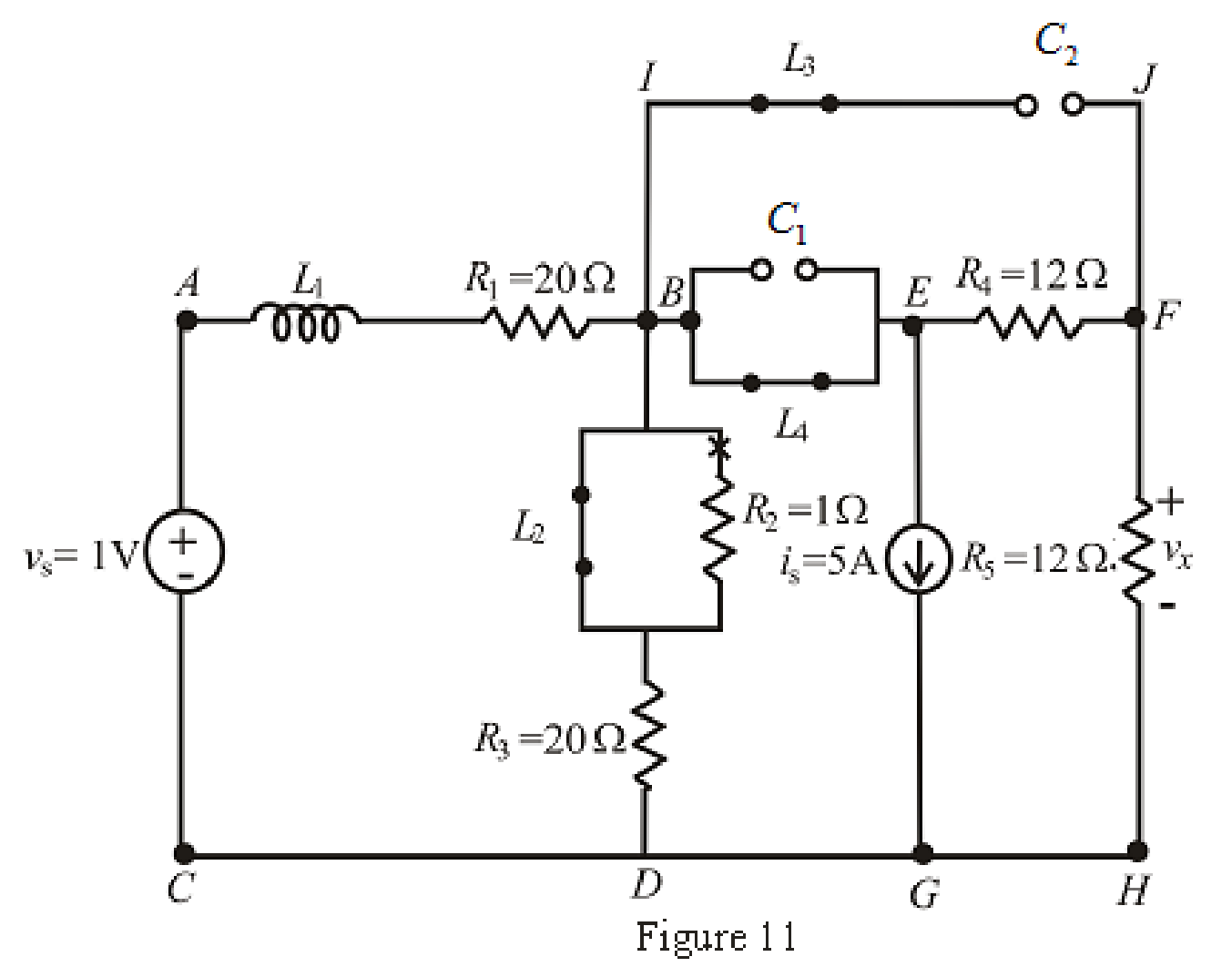
When steady state is reached, the inductor connected across branch
The redrawn circuit is shown in Figure 12,

Refer to the Figure 12:
The expression for the nodal analysis at node voltage
The expression for the current across the resistance
The expression for the voltage across the resistance
The current across the resistances
Substitute
Solve for
Substitute
Substitute
Conclusion:
Thus, the voltage
Want to see more full solutions like this?
Chapter 7 Solutions
ENGINEERING CIRCUIT...(LL)>CUSTOM PKG.<
- 50mV and 10kHz from the function generator to the input. The mulitmeter postive is connected to the output and negative to a ground. Is the circuit connected correctly? Yes or No. Does the reading look correct? I don't need calculations but will take them. I just need to know if the connection is right. Connect a signal generator to the input and set it for 50 mV Sine wave with a frequency of 10 kHz. Connect the output to a multimeter set to RMS voltage. Record the output voltage and frequency in the following table. Repeat the measurement for all given frequency values in the table.arrow_forwardThe input reactance of an infinitesimal linear dipole of length A/60 and radius a=A/200 is given by Xin = – 120 [In(€/a) — 1] tan(ke) Assuming the wire of the dipole is copper with a conductivity of 5.7 x 10' S/m, determine at f = 1 GHz the (a) loss resistance (b) radiation resistance (c) radiation efficiency (d) VSWR when the antenna is connected to a 50-ohm linearrow_forwardExample Solve the octic polynomial 2x⁸-9x⁷+20x⁶-33x⁵+46x⁴-66x³+80x²-72x+32=0 Solution Divide by x⁴ 2x⁴-9x³+20x²-33x+46-66/x + 80/x² - 72/x³ + 32/x⁴=0 Combine and bring terms 2(x⁴+16/x⁴) - 9(x³+8/x³) +20(x²+4/x²)-33(x+2/x) + 46= 0 Let use substitution Let x+2/x =u (x+2/x)²= u² x²+2x*2/x + 4/x² = u² x²+4/x²= u²-4 (x+2/x)³= x³+8/x³+3x*2/x(x+2/x) u³= x³+8/x²+6u x³+8/x³= u³-6u (x²+4/x²)²= x⁴+2x²*4/x² + 16/x⁴ (u²-4)²= x⁴+16/x⁴ + 8 x⁴+16/x⁴ = (u²-4)²-8 x⁴+16/x⁴ = u⁴-8u²+8 2(u⁴-8u²+8)-9(u³-6u)+20(u²-4)-33u+46=0 Expand and simplify 2u⁴-9u³+4u²+21u-18=0 After checking (u-1)(u-2) Are factors Then 2u²-3u-9=0 u=3, u=-3/2 Assignment question Solve the octic polynomial 2s⁸+s⁷+2s⁶-31s⁴-16s³-32s²-160=0 using the above example question, please explain in detailarrow_forward
- b) Another waveform g(t) is defined by =0 t≥0, α>0 otherwise g(t)= At exp(-at) and is plotted in Figure 1 (for representative values of 4 = 1 and α = 1). g(t) 0.4T 0.3+ 0.2 0.1+ 2 0 2 Figure 1 8 c) Show that its amplitude spectrum is |G(@)| = - A (a²+0²)² Describe briefly, with the aid of labelled sketches, how changing a affects the waveform in both the time and frequency domains. d) Deduce the Fourier transform H(@) of h(t) = g(t)+g(t+b)+g(t-b) and calculate its DC amplitude H(0).arrow_forward"I need an expert solution because the previous solution is incorrect." An antenna with a radiation impedance of 75+j10 ohm, with 10 ohm loss resistance, is connected to a generator with open-circuit voltage of 12 v and an internal impedance of 20 ohms via a 2/4-long transmission line with characteristic impedance of 75 ohms. (a) Draw the equivalent circuit (b) Determine the power supplied by the generator. (c) Determine the power radiated by the antenna. (d) Determine the reflection coefficient at the antenna terminals.arrow_forward--3/5- b) g(t) = 3 1441 g(t+mT) = g(t) -31 (i) Complex fourier coefficient Cn. (ii) Complex fourier coefficients - real fourier coefficient (the first 5 non-zero terms) of (iii) sketch the amplitude spectrum g(t) |Cal against n. n= -3 ⇒n=3 (labelling the axis).arrow_forward
- Q4) (i) Calculate the fourier transform of : h(t) 2T (is) h(t) 2T -T о T 2T ·(-++T). cos2t ost≤T (iii) hro (4) ((-++T). cos otherwisearrow_forwardQ2)a) consider the Circuit in figure 2 with initial conditions of Vc (o) = 5V, I₁ (o) = 1A, (i) redraw the circuit in the frequency domain using laplace Wansforms. (ii) using this circuit derive an equation for the Voltage across the inductor in the time domain.. 3.12 ww =V/3F ZH (figure 2) d) Solve the following second order differential equation using laplace transforms. d12 + 5 dx 3x=71 dt - with initial conditions x² (0) = 2, α(0) = 1arrow_forwardb) Another periodic waveform is defined by T c) g(t)= T with g(t+mT) = g(t) and m is an integer. (i) Sketch g(t) over two full cycles in the time domain, labelling the axes. (ii) Derive the formulae for the complex Fourier coefficients c₁ for g(t). For a periodic waveform h(t), if its complex Fourier coefficients are T T when n is odd T 2n²² T 4nn when n is even and not zero 4nn please derive the first five non-zero terms of the real Fourier series for h(t).arrow_forward
- Q3)α) f(t) = (-+- 1 Isto f(t+mT) = f(t). L+- I Ost ST integer (i) sketch f(t) 2 full cycles time domain. (labelling the axis). (ii) Derive the formula for the real fourier Coefficients (i) Real Fourier series f(t), first 5 non-terms. an bn for f(t).arrow_forwardQ3. a) A periodic waveform is defined by T 3 0≤t< f(t) = SIarrow_forwardQ2. a) Sketch the following waveform f(t)=Vo -1/2≤t≤1/2 =0 otherwise and show that its Fourier transform is 2V ωτ ωτ F(s)-sinotsinc) 2 Use this result to sketch a fully labelled graph of the amplitude spectrum of a single square voltage pulse, of amplitude 24V and pulse width 1.4μs, using units of Hz for the frequency axis. (Note: graph paper is not required - a clear, fully-labelled sketch is adequate).arrow_forwardarrow_back_iosSEE MORE QUESTIONSarrow_forward_ios
 Introductory Circuit Analysis (13th Edition)Electrical EngineeringISBN:9780133923605Author:Robert L. BoylestadPublisher:PEARSON
Introductory Circuit Analysis (13th Edition)Electrical EngineeringISBN:9780133923605Author:Robert L. BoylestadPublisher:PEARSON Delmar's Standard Textbook Of ElectricityElectrical EngineeringISBN:9781337900348Author:Stephen L. HermanPublisher:Cengage Learning
Delmar's Standard Textbook Of ElectricityElectrical EngineeringISBN:9781337900348Author:Stephen L. HermanPublisher:Cengage Learning Programmable Logic ControllersElectrical EngineeringISBN:9780073373843Author:Frank D. PetruzellaPublisher:McGraw-Hill Education
Programmable Logic ControllersElectrical EngineeringISBN:9780073373843Author:Frank D. PetruzellaPublisher:McGraw-Hill Education Fundamentals of Electric CircuitsElectrical EngineeringISBN:9780078028229Author:Charles K Alexander, Matthew SadikuPublisher:McGraw-Hill Education
Fundamentals of Electric CircuitsElectrical EngineeringISBN:9780078028229Author:Charles K Alexander, Matthew SadikuPublisher:McGraw-Hill Education Electric Circuits. (11th Edition)Electrical EngineeringISBN:9780134746968Author:James W. Nilsson, Susan RiedelPublisher:PEARSON
Electric Circuits. (11th Edition)Electrical EngineeringISBN:9780134746968Author:James W. Nilsson, Susan RiedelPublisher:PEARSON Engineering ElectromagneticsElectrical EngineeringISBN:9780078028151Author:Hayt, William H. (william Hart), Jr, BUCK, John A.Publisher:Mcgraw-hill Education,
Engineering ElectromagneticsElectrical EngineeringISBN:9780078028151Author:Hayt, William H. (william Hart), Jr, BUCK, John A.Publisher:Mcgraw-hill Education,





